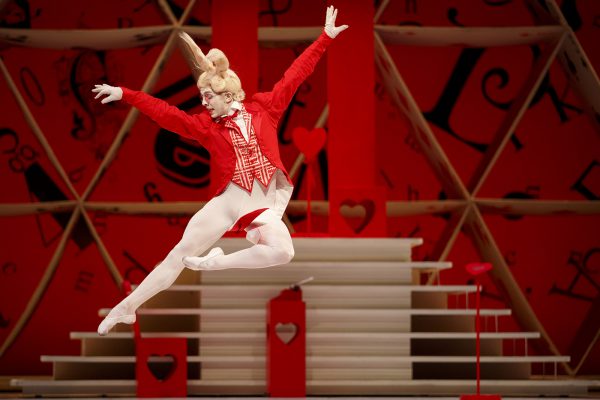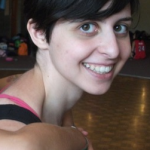“We’re all mad here,” the Cheshire Cat explains to a bewildered Alice in Lewis Carroll’s literary classic. “You must be [mad],” he adds, “or you wouldn’t have come here.”
Carroll’s madcap logic and playfulness survives — and thrives! — in The National Ballet of Canada’s delightful Alice’s Adventures in Wonderland, which had its Toronto premiere in 2011. This co-production with The Royal Ballet reassembles zany elements of the original 1865 text of the same name, minus the witty wordplay, transforming it into a fabulous piece of entertainment that’s equal parts dance, comedy, visual spectacle and subtle social commentary.
The success is largely due to choreographer Christopher Wheeldon’s clever reframing of the story. Wheeldon and librettist Nicholas Wright set the ballet in Victorian England, where real-life Alice Liddell harbours a teenage crush on Jack, the gardener’s boy. Alice’s insufferably prim and ill-tempered mother, aware of the budding cross-class romance, fires Jack after falsely accusing him of tart theft. This injustice leads Alice to escape down a magical jelly mould. Aided by family friend Lewis Carroll (who transforms into the White Rabbit), she runs to save Jack (who becomes the Knave of Hearts).
The back story is key to this contemporary Alice: Wonderland isn’t a simple dream, it’s a metaphor for her mind, where she struggles to make sense of adolescent growth spurts, bafflingly diverse creatures and the world’s absurd and arbitrary rules. It’s when she puts her foot down and rejects the unfair treatment of Jack (without flying off into a vicious rage like her mother-turned-Queen of Hearts) that she literally tips the cards in her favour and awakens in today’s selfie-snapping world with her beloved. Alice as champion of social justice and diversity? Sounds like a stretch, but the construct makes this reading plausible, even if the performance keeps things light and fun.
The ballet itself is spectacular, with non-stop action packed into two hours and forty minutes, and surprises hidden behind every door, teapot and topiary. Alice’s psychedelic plunge into Wonderland echoes Hitchcock’s Vertigo spirals, and her drastic size changes are brought to life by Jon Driscoll and Gemma Carrington’s brilliant tunnel and door projections. The action is propelled by Joby Talbot’s cinematically quirky music, which would feel right at home in a Tim Burton film. Bob Crowley’s jaw-dropping designs paired with Natasha Katz’s lighting make each scene memorable, particularly Act III’s gorgeous garden mazes imbued with a blood-red glow.
It’s the attention to details that amaze. Take the dancers’ tutus in Act III, shaped into the four suits of a deck of cards. Or the folded paper boat that Alice and the White Rabbit sail on — literally a page from Carroll’s Alice’s Adventures in Wonderland (the title peeks out from the boat’s hull). Or the dancers whose legs and crystal-studded blue pointe shoes make up the undulating body of the Caterpillar — a visual treat that, sadly, lasts less than a minute. What really takes the tart (er, cake) is the scene-stealing Cheshire Cat. Manipulated by eight dancers, each of whom are responsible for a paw, a head or a tail, the Cheshire Cat is a grin-inducing, levitating feat of design, strangely distracting to a violent mob yet fragile enough to be disassembled by a sneeze.
It almost feels like the dancing takes a back seat to the spectacle, or is so inseparable from it that no single moment of pure dancing leaves an indelible mark. But that might be an unfair assessment — there is plenty of excellent dancing in Alice, especially from its lead character, played with spunk and stamina by Jillian Vanstone on opening night. Vanstone’s technique sparkles — with springy jumps and smoothly suspended attitude turns — but it’s her acting that draws the audience in. Whether she’s seasoning sausages, romping around a rose bush or sulking at a door that won’t budge, Vanstone infuses Alice’s movements with good-natured lightness and joy. It makes us root for her.
Naoya Ebe’s Jack/Knave of Hearts also dazzles with light leaps and secure tours en l’air. There is an odd lack of chemistry between him and Vanstone, however. Noticeable adjusting of feet during the supported promenades distracts from what could be a satisfying pas de deux.
Other zany denizens of Wonderland show off their skills. Dylan Tedaldi’s jittery White Rabbit flaunts jazzy extensions and crisply beaten hops. Robert Stephen displays wonderful musicality as a tap-dancing Mad Hatter — his pas de trois with a March Hare and tail-twirling Dormouse is utterly charming. Other standouts include Harrison James’ slinky, ab-isolating Caterpillar, Rex Harrison’s browbeaten King of Hearts, and finally Piotr Stancyk in drag as the hilarious, baby-tossing Duchess — who even stays in character through curtain call.
Hats off to Greta Hodgkinson, who literally dominates the stage as she’s wheeled around in a larger-than-life red dress. Her menacing Queen of Hearts, all bulging eyes and laser-like fingers, is a cartwheeling, axe-wielding, piqué-turning perfectionist who makes perfect splits uproariously funny. Her grotesque parody of the classic Rose Adagio with four reluctant partners draws the loudest laughs. It would be lovely to see her dance the real Rose Adagio in June, when the National Ballet stages Sleeping Beauty.
Wheeldon choreographs a few notable dances for the supporting cast, including Act I’s sweeping waltz of the flowers along the orchestra’s aisles, and Act III’s head-shaking march of the playing cards. Tight spacing, a frenetic pace, constantly moving set pieces and the domino-style choreography mean there is no room for error. A few missteps occur on opening night, when a line of male dancers perform consecutive corkscrew jumps — two out of eight land off-kilter and have to steady themselves. In another scene, Alice imagines dancing with her sisters — one of them almost collides with her and doesn’t finish the movement.
But overall, the National Ballet’s Alice is a marvelous ballet that offers something for everyone. Dance aficionados will enjoy choreographed allusions to famous ballets. Vaudeville and slapstick fans will be pleased to find humour in spades (and hearts, diamonds and clubs, for that matter). Bookworms will read evidence of Carroll’s mad wit translated through movement. And kids on March Break will see something amazing to gape at every minute. Even if it doesn’t quite tug at the heartstrings, Alice succeeds at creating a wonderful piece of entertainment — and sometimes, that’s all we really want from a ballet.~






